Ikoria: Lair of Behemoths Mechanics
The new set Ikoria: Lair of Behemoths brings us to Ikoria, a breathtaking world where an enterprising Planeswalker such as yourself can find sights unlike any other. Massive crystal formations, unfathomable caverns, towering spires, and more await you. But we didn't name the set Ikoria: Lair of Annoying Tourists for a reason. There are those behemoths, after all. Are you friend or food? Your mastery of the new abilities here may make the difference.
Cycling
Cycling is a fan-favorite mechanic that helps you find the perfect card, assuming the perfect card is somewhere near the top of your library.
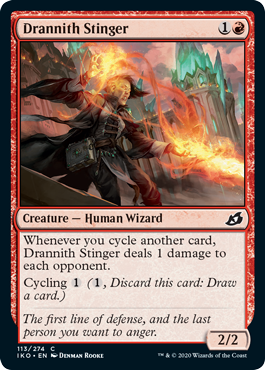
Cycling lets you trade a card in hand for a new card. Maybe it's late in the game and Drannith Stinger isn't going to cut it. Maybe you already control a Drannith Stinger and need that extra 1 damage. Whatever the reason, cycling a card gives you another shot at finding the card you need.
Cycling abilities work while the card with cycling is in your hand. Each cycling ability has a cost. In this set, the cycling costs are just mana, but non-mana cycling costs have appeared on previous cards. To activate a cycling ability, pay that cost and discard the card with cycling from your hand. As the cycling ability resolves, you'll draw a card.
Some cards have additional bonuses for cycling them. These are written "When you cycle [this card's name], [effect]." They will happen before you draw a card for the cycling ability. Some permanents, such as Drannith Stinger, have an ability that rewards you for cycling other cards. These work only if the permanent with that ability is on the battlefield as you cycle the other card.
Keyword counters
Ikoria introduces keyword counters. Just as a +1/+1 counter gives the creature it's on +1/+1, these keyword counters give the permanent they're on the listed ability. This allows some spells and abilities to have a little more staying power.
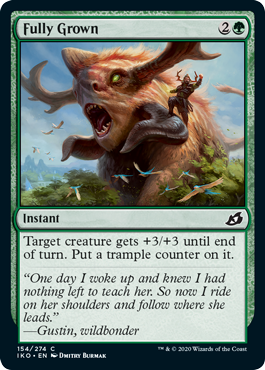
For your convenience, we've made punch-out counters to easily track which creature has which ability. Using them is optional, but they can be very handy once several kinds of keyword counters are spread around.
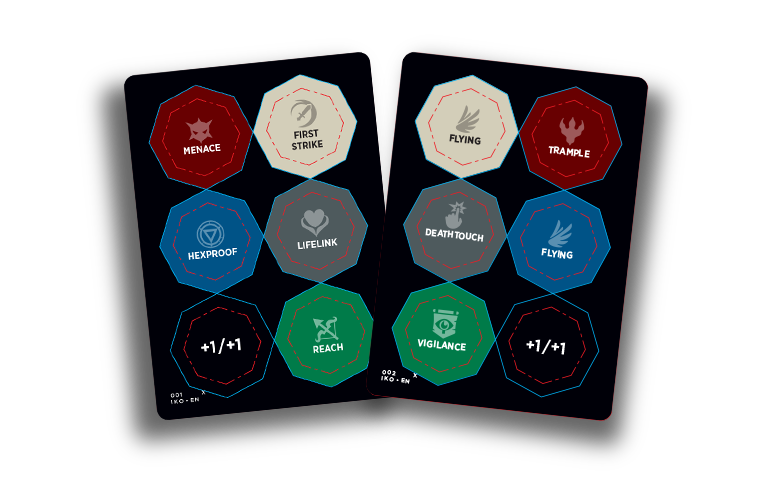
For this group of counters, having more than one of the same counter provides no additional benefit. Note that if one of these counters ends up on a noncreature permanent, it won't necessarily apply right away, but it will if the permanent becomes a creature. Hexproof counters will be effective even if on a noncreature permanent, as will deathtouch and lifelink counters, provided that noncreature permanent can deal damage somehow.
Mutate
Mutate is a new keyword that lets you combine creatures in a new way to build better monsters. You know, for fun and smashing.

Every creature card with mutate gives you two ways to cast the spell. Somewhat predictably, the first is just cast it for its mana cost. Somewhat safe. Reasonably reliable. Hope it works out for you. The second option is a little more exciting: rather than just cast the creature spell, let's cause a creature on the battlefield to mutate! Here's how it works.
When you cast a creature spell for its mutate cost, a few things change about how you cast it. First, you pay the mutate cost rather than the mana cost. Second, the spell will require a target. Specifically, a target non-Human creature you own. Humans on Ikoria spend all their energy merely surviving, so their cells just aren't up for the mutation thing, I'm guessing. Mutate can be used only if you're casting the spell. If a creature card with mutate enters the battlefield some other way, it just enters the battlefield.
As a mutating creature spell resolves, instead of entering the battlefield, it merges with its target into one creature. Its controller chooses to put the resolving mutating creature spell on top of its target or underneath it. You'll end up with a pile of cards (or tokens—we'll get to that in a second) that all represents a single creature. That creature will have all the characteristics of the top card, and it will also have the abilities of every card underneath.
For example, let's say you cast Cloudpiercer for its mutate cost with Mosscoat Goriak as the target. As Cloudpiercer resolves, you can put Cloudpiercer on top, in which case you end up with a 5/4 red Dinosaur with mutate, reach, that triggered ability we'll definitely get to in a second, and vigilance. If you instead put Cloudpiercer on the bottom, you'll end up with a 2/4 green Beast with the same suite of abilities.
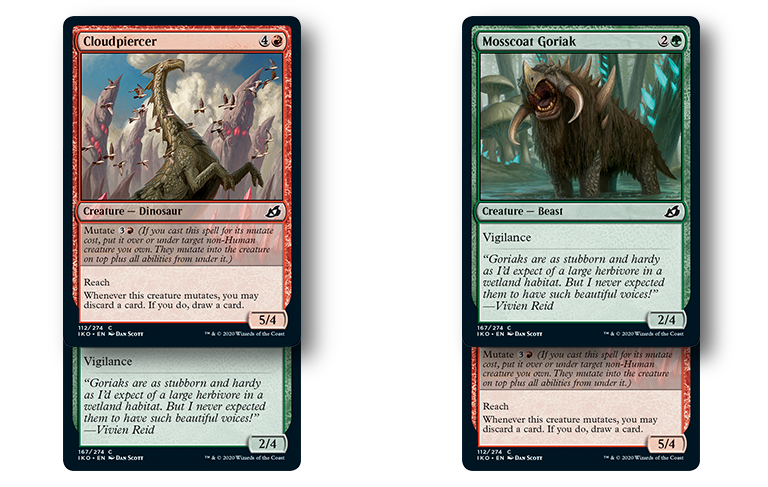
In most cases, power and toughness will guide your decision. Having a 5/4 with some abilities is usually better than having a 2/4 with the same abilities. But remember that the creature's name, converted mana cost, colors, and creature types are all determined by the top card. You may even find that rare situation where you want a creature to be smaller so as to avoid smiting or banishment or whatever it is they do to large creatures here.
The resolving mutating creature spell doesn't enter the battlefield. It simply makes the creature that was already on the battlefield change characteristics. If that original creature was tapped, the new merged creature is tapped. If it had any counters on it, or Auras or Equipment attached to it, it still does. And it's still presumably a non-Human creature you own, so you can cast another creature spell with mutate and have a third card join the pile. Same rules apply: the new card goes on top or on the bottom and will change the creature's characteristics accordingly. Why would you want to mutate over and over again onto the same creature?
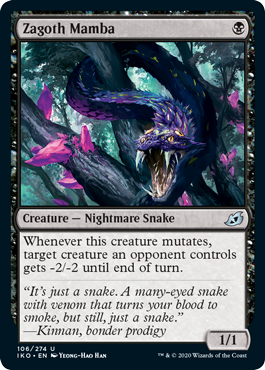
One reason is those "Whenever this creature mutates" triggered abilities. When a mutating creature spell resolves, all triggered abilities the resulting creature has with that trigger condition will trigger. It doesn't matter if the ability is on the existing creature (before it mutated) or on the new piece (the resolving mutating creature spell). They all trigger, and they can be put on the stack in any order.

Some creatures, like Bristling Boar above, have abilities that refer to themselves by name. Remember that from a rules perspective, a card using its own name in an ability really just means "me." For example, if Cloudpiercer ends up on top of Bristling Boar, that ability will work on the resulting creature.
If all goes well, the mutated behemoth you've created will go on to pulverize your opponent and you'll win the game. But I suppose they might get lucky and find a way to get your creature off the battlefield. What then? If a mutated creature leaves the battlefield, all of its components go to the appropriate zone. So if it dies, each card ends up in the graveyard. Any ability that triggers "whenever a creature you control dies" or similar will trigger only once. Same with exile, your hand, or your library. If it's put into a specific position in your library, such as on the bottom or third from the top, you choose the relative order of the cards.
We've covered what happens when a mutating creature spell resolves. But what if it doesn't? While it's on the stack, a mutating creature spell is still a spell, so it can be countered. If one is countered, it heads to the graveyard as you'd expect. But here's something you may not expect: if a mutating creature spell tries to resolve but can't because its target is illegal or has gone missing, the mutating creature spell will simply resolve and enter the battlefield. So, it's not quite an "all Dinosaur eggs in one basket" kind of risk. One note though: although the spell resolves and the creature enters the battlefield, any "Whenever this creature mutates" abilities it has won't trigger.
Remember that the targeting requirement for a mutating creature spell is a non-Human creature you own. (Technically, it's a non-Human creature owned by the same player as the mutating creature spell, but casting such a spell you don't own is pretty unusual.) Nowhere in that phrase is the word "nontoken." Tokens can mutate just like nontoken permanents can. For any merged creature, if a token is on top, the creature is a token. If a card is on top, the creature is a nontoken permanent.
Mutate is the kind of keyword that includes a lot of rules innovation, and that can be distracting. But make no mistake: smashing your monsters into other monsters and making buffed-up supermonsters and rampaging over your rivals is pretty sweet, and I can't wait to see what combinations you all come up with.
Companion
There are ten companions in Ikoria, each one a legendary creature whose companion ability lists a deck-building rule. If your starting deck follows that rule, then the legendary creature can serve as your chosen companion. For example, if our majestic friend Keruga is going to be your chosen companion, then your starting deck can't include any cards with converted mana cost 1 or 2.
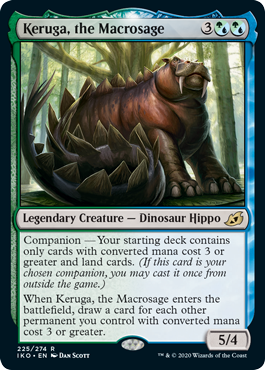
You can have up to one chosen companion for each game. That chosen companion doesn't start in your main deck. Rather, it's a card in your sideboard. (If you're playing casually without sideboards, it's just in your collection outside the game. All the same rules apply to it.) This means it doesn't count as a card toward meeting the minimum deck size in the format you're playing, but in Constructed formats, it is one of your fifteen sideboard cards. Just before the game begins, reveal your chosen companion to all players. Once during the game, but only during your main phase if the stack is empty, you can pay {3} to put your chosen companion into your hand. (Note this is a change from previous rules. The printed reminder text indicating you can cast the card is no longer accurate.)
Once you bring your chosen companion into the game, it stays in the game for good. It's in your hand, so it can be cast, discarded, and so on. If you later cast it, it goes on the stack. If it resolves, it will enter the battlefield under your control (yay!). If it's countered, it will go to your graveyard (boo!). Once it's in the game, it can be exiled, shuffled into your library, etc. It won't return to your sideboard until the game ends.
Your companion's deck-building rule applies only to your starting deck, which is the deck you begin play with each game. It won't consider any cards in your sideboard, so those cards don't have to follow the deck-building rule. Additionally, you can just ignore the deck-building rule and include creature cards with companion in your main deck. This is especially relevant to formats like Booster Draft, where following the deck-building rule may not be possible. But if you can pull it off, glory awaits.
So, the companions are legendary creatures who begin outside your starting deck and have great influence over the rest of your deck. Where have I heard this before? Ah yes, Commander. Commander players, even though you don't have sideboards, you can still get in on the fun. Each Commander deck may include a chosen companion. It starts outside the game and doesn't count as one of your 100 cards. Just like the rest of your deck, your commander must follow the deck-building rule if you're going to use a companion.
As a puny human, you may be hopelessly outclassed by the monsters roaming Ikoria, but at least you won't have to fight alone!

